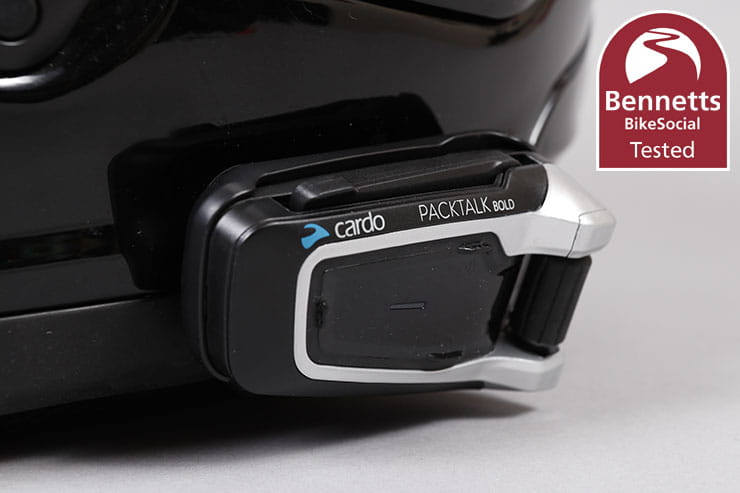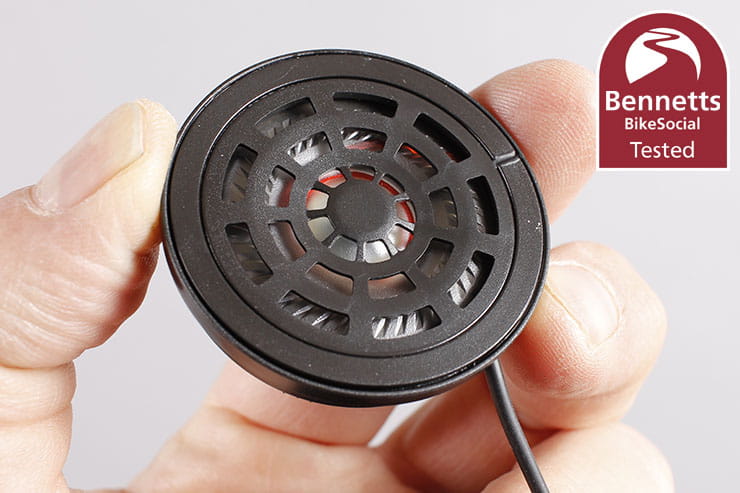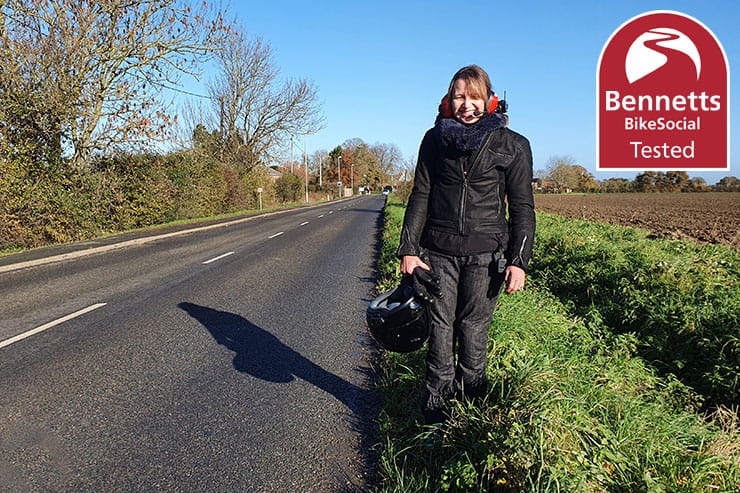Date reviewed: November 2020 | Tested by: John Milbank | Price: £305.99 / £349.99 | www.pama.com/cardo / www.cardosystems.com
The £349.99 Cardo Packtalk Black is the company’s flagship intercom, boasting Mesh communication, 45mm JBL speakers, connectivity to your phone for calls, GPS and music, an FM radio and of course rider to pillion and rider to rider connectivity.
The £305.99 Cardo Packtalk Bold has all the same features, but has 40mm JBL-branded speakers instead. Other than that, the Bold has silver highlights and a two-year warranty while the Black is, well, black and has a three-year warranty.
I’ve been using both units on an Arai RX-7V and an Arai Tour-X4 to find out what the differences are, whether they make for the best all-in-one bike communications system and if paying the extra for the Packtalk Black is worth it…
UPDATE: For the latest Cardo and Sena intercom updates, including new cross-platform compatibility, GoPro control and voice recording features, check our updates feature here.
For and against
- Mesh gives excellent clarity across large groups or one-to-one
- Superb voice-control
- Compact and easy to use
- Range not as good as some of the competitors
- Still needs connecting to a computer to update
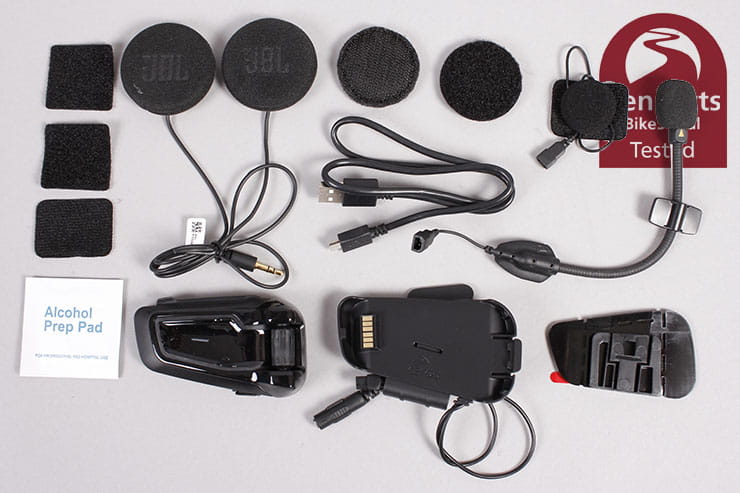
Fitting
Fitting any intercom will require some degree of stripping your helmet down, so how easy it is will vary, but on a full-face lid, the supplied wired microphone attaches with a Velcro pad, while the speakers tuck into the ear areas.
On Arais, that means taking the cheek pads out and lifting the removable fabric covers. There tend to be sections of foam cut out here that can be removed, but once done, the Bold speakers fit fine, as do the thicker Black 45mm drivers. It’s worth noting that before removing the pieces of foam from my Arai’s cheek pads, my left ear started to get a bit sore after about an hour with the 45mm speakers. With the foam out they’ve been fine, but do keep in mind that they take up that bit more space if your lid is particularly snug.
Comfort will of course vary depending on your head shape and helmet, but most lids tend to have recesses for intercom speakers now – if in doubt, have a look inside or check with your dealer.
The Packtalk Black’s speakers are thicker than the Bold’s
A boom mic is also supplied, which you’ll use on a flip-front or open-face helmet.
I’m extremely impressed with the Cardo mounting system – there’s a very slimline stick-on pad, or a really compact clip, which simply slides up between the liner and the outer shell to hold the unit securely in place. It adds very little bulk to the device, making this an extremely sleek-looking bit of kit, especially given that it incorporates a handy scroll wheel. Of the universal intercom units I’ve tested so far, only the Cardo Freecom has a more sleek design.
The speakers are linked to the unit with a standard 3.5mm TRS (tip, ring, shield) connector, which does take up a little more space than it could, though I’ve tended to find it easy to tuck into gaps in the helmet’s lining. If you wanted, you could plug standard headphones or earbuds into this.
The wired mic tucks easily into most full-face lids, while the boom mic is designed for open-face and flip-front helmets
Connections
When it comes to the intercom, Dynamic Mesh Communication (DMC) allows up to 15 users to join a group and, once set up, when any of them are in range they’ll automatically connect. This is an improvement over Bluetooth comms as when riding in groups, if any rider loses connection the group falls apart, which means they have to stop to pair up again.
Mesh makes things a lot simpler as you can set it up once then forget about it, and unlike Bluetooth, it doesn’t matter if the riders change their order on the road, or if one leaves the pack.
If you ride in a group of more than two and want to be able to communicate, it really is worth buying a Mesh system, but do bear in mind that Cardo and Sena’s Mesh systems aren’t compatible, although a Bluetooth intercom owner can be bridged into the conversation (that’ll be a lot easier if it’s still a Cardo). Interestingly, Sena and Interphone and struck a deal that sees their new devices from 2021 sharing Mesh compatibility.
Everyone in a mesh group can hear the conversation, but you can talk privately if you choose them from the app (assuming you have it mounted on the bars), or by pairing them via Bluetooth before you ride and switching over with the top button.
While Mesh intercoms will not work across different brands, the Cardo has a Bluetooth intercom pairing ‘gateway’, which is said to allow the linking of non-Cardo units. This paired as an Intercom with an old Interphone Sport, but it was a little tricker with Sena.
To pair a Sena 50S to a Cardo Packtalk you need to carry out the following steps, though it will be a similar procedure for other Sena and Cardo devices:
- Put the Cardo in phone pairing mode by pressing and holding the phone button for five seconds, until the LED flashes red. If you want to use the ‘second mobile phone option’ tap the phone button twice when the LED is flashing red.
- Access ‘universal pairing mode’ on the Sena by holding the jog dial down until you get to the configuration menu, then turn the dial anti-clockwise twice until you hear ‘universal pairing’. Finally, press the phone button on the rear of the Sena to activate pairing and the two should link up.
This isn’t as slick as it could be. It seems to be the same process when connecting the Sena to an old Interphone F5MC, but interestingly, the Cardo paired without issue to the same device.
The clip is a great way to secure the Cardo, but a stick-on bracket is also supplied
Having multiple devices paired with the Cardo works well, though do check the priorities setting in the app – switching it to ‘Audio sources’ means that music and GPS instruction are allowed to interrupt an active intercom call. Audio can be mixed in Bluetooth mode, but I have that turned off as I find it distracting hearing multiple sources.
With the radio or music on, my Galaxy S10’s GPS or a separate TomTom have no problem breaking in to give directions (and the phone is particularly clear), but the TomTom does get delayed a little if there’s music playing, resulting in some clipping of the start of the instruction. This didn’t happen with the radio on, so it’s just a small issue with the phone’s streaming.
With a Bluetooth intercom connection, my phone interrupts the conversation for directions, but my TomTom doesn’t. I found this was an issue with the Freecom 1+ too, and it could be a TomTom thing, but given that I’m using the newest 550, which is fully up to date, it’s a bit irritating. Even enabling audio mixing doesn’t clear it, but switching audio priority to ‘Intercom’, which means the phone won’t play audio during an intercom connection, the GPS does interrupt (it shouldn’t).
Switching the TomTom to ‘High Quality (A2DP) cures it when the sat-nav is paired as a GPS, but then it won’t interrupt music that’s playing from your phone.
There is a way to fix this though – by pairing the TomTom as ‘mobile phone two’, rather than as a GPS, it successfully interrupts calls.
When a Mesh intercom is running, all the Bluetooth functions work as they should, including the TomTom, though they do mix the audio, so it might be hard to hear over people talking.
During a Mesh intercom call, you can easily mute the group (along with your microphone) if you want a bit of peace and quiet by pressing the jog dial in for two beeps. This does mean though that others won’t be able to reconnect you in, so if using it as a one-to-one intercom, Bluetooth might be the better choice as either person can reinitiate the connection.
The antenna does need to be up to get the best intercom range
Control
Having voice control built into the Packtalk Bold and Black makes using the device really simple, without ever having to take your hands off the bars. Here’s a list of everything you can say to control the unit:
Radio
- Hey Cardo, radio on
- Hey Cardo, radio off
- Hey Cardo, next station
- Hey Cardo, previous station
Bluetooth music
- Hey Cardo, music on
- Hey Cardo, music off
- Hey Cardo, next track
- Hey Cardo, previous track
Audio control
- Hey Cardo, volume up
- Hey Cardo, volume down
- Hey Cardo, mute audio
- Hey Cardo, unmute audio
Phone
- Hey Cardo, speed dial
- Hey Cardo, redial number
- Answer
- Ignore
Other
- Hey Cardo, battery status
- Hey Cardo, call intercom
Assistants
The Cardo Packtalk Black is, well, black. The Bold has silver accents
I’m not the clearest of speakers, with a touch of lisp too, but generally the voice commands work very well indeed, with only the odd glitch like ‘Music off’ being interpreted as ‘Radio on’.
The system seems to recognise my phrases quite well, and it’s not over-complicating itself too much; for instance, it only seems to really listen for the ‘music oh’ shape of sound; whether you say ‘on’ or ‘off’ it’ll just toggle between its current state.
What’s vital is that as soon as you get the device, you use the app on your smartphone to change the language to suit you. ‘English US’ simply doesn’t work with my accent, but ‘English UK’ fixes it.
Using ‘OK Google’ shows the limitations of voice control as I found it hard to use it to call my wife while riding – it’d connect to the assistant fine, but then couldn’t understand my commands. Off the bike and with the phone in my hand it works a treat, so clearly the complexity of these instructions and the wind noise is currently pushing things too far for the phone.
Pretty much everything is covered with voice commands, though you can only select the first of the four speed dials that can be set up and accessed through the app. But I now only really touch the unit to change the volume (though I needn’t), and that’s not needed much as the auto-volume setting does an excellent job of keeping it at a good level depending on wind noise.
The quick-start guide tells you all you need, but if you want them full instructions you’ll need to download them from the Packtalk website
The jog dial on the back of the Packtalk is very easy to use with gloved hands, but cleverly positioned to not foul or change when you do a shoulder check – even when twisting my head and leaning it over, the Cardo can touch, but it doesn’t interfere with even bulky armoured kit.
While it won’t matter to most users, it’s slightly confusing to find that the button layout of the Freecom 1+ and Freecom 2+ doesn’t match that of the Freecom 4+ or the Packtalks. You’ll of course get used to it, but as I upgraded from a Freecom 1+, and that’s what’s still on my wife’s lid, it took me a while to realise why I was struggling to pair them up.
While the jog wheel is very easy to find, the small buttons on the face of the device are less obvious, especially with thick gloves on. Once you get used to their position, they’re very usable, but that voice recognition is so good it’s not a problem.
The app is a useful way to access the Cardo’s functions, even on the move
Another way to control your device is with the app if you have your phone mounted to the bike’s bars. For most options, this has large controls that allow you to control music, radio, calls and the intercom, including activating a private chat in Mesh, though once on a ‘page’, like that for the music player, getting out of it to access other options requires pressing a small ‘X’ in the top left corner. As long as your gloves have good touch-screen compatibility, this is useful for a couple of the less used features that aren’t available through voice control. While the app’s a useful addition, irritatingly it won’t work with the phone on its side, which is how I like to use it for navigation.
Under ideal conditions, the 45mm speakers in the Cardo Packtalk Black are noticeably better than the 40mm ones in the Bold
Volume and clarity
Using ‘Innocence’ by Keeno as a sample track thanks to its deep bass and sparkling high tones (and because it’s one of my favourite riding tracks), with the Cardo Packtalk Black’s premium 45mm speakers, the track is very clear and crisp in a test environment, with barely any distortion at full volume. Bass notes are superb, and with the drivers tucked inside my cheap Screwfix ear defenders, it’s easy to imagine I’m wearing a pretty good quality pair of cans.
With ‘bass boost’ tuned on in the app, there is a little distortion, but I prefer a clean, less processed sound.
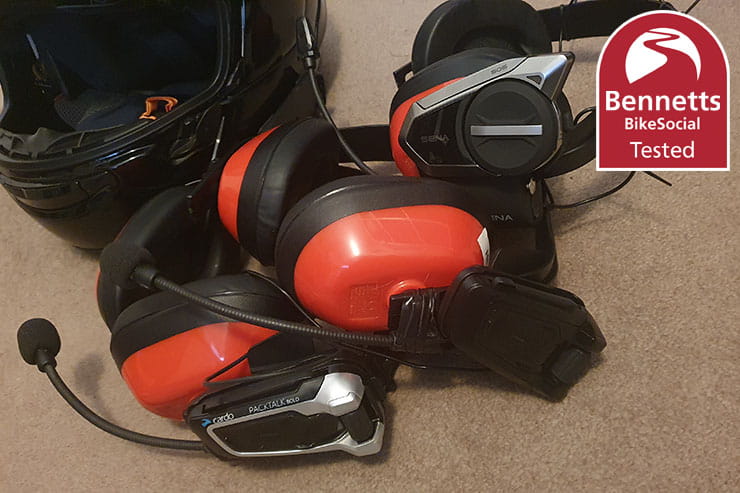
Testing audio quality using a pair of ear defenders allows me to more accurately compare the quality of the output. Obviously I also run them in a helmet on various bikes at different speeds too…
With the Packtalk Bold running the 40mm standard speakers (still JBL branded), the audio is far from bad, but it doesn’t have the depth of the 45mm drivers, sounding just a bit cheaper when compared back to back.
Switching the bass boost on in the Cardo app does give a bit more low-end to the Bolds, but it carries a small amount of distortion, especially at full volume.
When I reviewed the Cardo Freecom 1+ I had the chance to try the optional JBL 45mm speakers (with audio profile), and wasn’t that impressed given that they cost an additional £84.98. They load the Packtalk Black by £45, so would I recommend them now?
Yes and no. I’m in no doubt that they deliver a more rich and dynamic sound than the 40mm speaker, and in fact the Packtalk Black is the best-sounding intercom I’ve ever tested. But with earplugs in at 70mph the differences are less noticeable.
Speech quality is excellent – on calls home to my wife, even riding the Royal Enfield Interceptor 650 she could hear me clearly at above motorways speeds
Audio quality in Mesh communication is excellent, and in my testing of three devices, having riders swap places while at the limit of connection caused no problems, the units keeping all riders in conversation.
In Bluetooth intercom mode, which I tested using two devices, interference crept in after about half the maximum range I achieved. I also found that, once the connection was lost, the conversation ended. The devices were still paired, but you had to keep pressing the ‘talk’ button until they were close enough together to link up again (which was about two thirds of the maximum range achieved).
The noise-cancelling is superb, cutting out any wind noise and keeping the airwaves silent until someone is speaking. Of course, the fit and noise of your helmet will have an influence on any intercom’s performance, but the Cardos perform brilliantly when in range.
Volume is very good. I always wear earplugs, even when using an intercom and the Cardo Packtalk Black and Packtalk Bold both have enough power to give good, clear audio at motorway speeds, though this will of course depend on your bike and helmet. I’ve tested the units on a BMW S1000XR and a Royal Enfield Interceptor 650.
The auto-volume feature works well, adjusting the volume to suit the ambient noise in a very unobtrusive way – this is a far cry from older devices that would suddenly go too loud or too quiet
Quick tip: If you have a compatible Samsung phone, use Bixby routines to automatically set your phone’s media volume to full whenever the intercom connects – this means all the volume is there to be controlled from your Cardo, rather than realising a few miles into a ride that the phone is only outputting half power.
To ensure repeatability, the additional ‘rider’ stood by the side of the road with the units attached to ear-defenders
Cardo Packtalk Black / Packtalk Bold intercom range
All intercom manufacturers make their own claims about range, but this is under ideal conditions. I always test devices at the same straight, flat road with no traffic, as well as in a village location and in a very built-up area, which gives a clear comparison of the units tested.
|
Cardo Packtalk Bold/Black
|
Maximum range
|
|
Mesh intercom
|
800m
|
|
Bluetooth intercom
|
780m with interference from 450m
|
Cardo claims close to 1km in ‘real life conditions’, and this test was carried out with one device on an Arai RX-7V, and the other attached to a pair of plastic ear-defenders. My wife, standing in one spot and facing the same direction, speaks continuously as I ride away to see when the connection is lost.
To check these figures and to make sure the helmet wasn’t causing any interference, we ran the test again with me also using ear defenders to carry the intercom while I rode a push-bike; the distances were exactly the same.

The ranges achieved on my straight test road are okay, but not the best I’ve seen
Mesh allows for greater total range in a group as the signal effectively bounces off of each unit. Up to 15 riders can join a Mesh group on the Cardo Packtalk Bold or the Packtalk Black, which gives a claimed maximum of up to five miles between a minimum of six riders.
While I was unable to test with a group of that size, I had one ‘rider’ stand in a set location with a unit attached to ear defenders, then rode off until the limit of the connection. There, the second ‘rider’ stood and turned their unit on. I then rode off as ‘rider 3’ to check that we were all able to continue talking.
The test was carried out on the edge of a quiet village, with no traffic between the units.

Here you can see where the ‘riders’ were for the Mesh test. Rider 1 is effectively the tail rider of this test, rider 2 marks the limit of that connection, then rider 3 shows how the Mesh system increases range while keeping everyone in conversation
|
Mesh test
|
Rider 1 to rider 2
|
Total rider 1 to 3
|
|
Cardo Packtalk Bold/Black
|
260m
|
640m
|
The distance from rider 1 to rider 2 was surprisingly short, but this is a real-world scenario and it’s important to remember that this acts as a comparison to other Mesh-enabled devices that we test (like the Sena 50S). The road opened up out of the village shortly after where rider 2 stood, so the range from them to rider 3 was greater, making for a total distance of 640m between riders 1 and 3. As rider 3 lost connection, riders 1 and 2 were still able to continue talking.
Once the maximum distance was recorded, I, as rider 3, then turned around and rode back past each of the other testers to ensure the Mesh would stay connected as the order changed around. Both testers turned 180° as I rode past, so we were always facing the same direction.
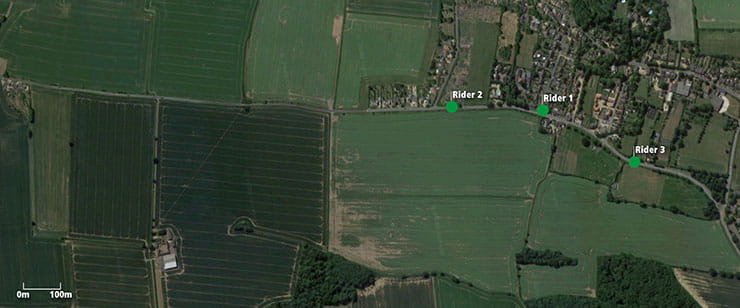
This is the second part of the Mesh test – riders 1 and 2 stayed where they were, but rider 3 (me) turned around and rode past them until the connection was again lost. Everyone faced the same direction, and here rider 2 was able to talk to rider 1 still, and until the limit of the connection, rider 3 was part of the conversation.
|
Mesh test
|
Rider 2 to rider 1
|
Total rider 2 to 3
|
|
Cardo Packtalk Bold/Black
|
260m
|
500m
|
Going in the opposite direction, the road takes a turn past a tree and it’s into the village, creating more opportunity for the signal to be blocked. No traffic was between the devices during measurement.
Ultimately, the distances achieved in my testing are significantly down on claims, but the beauty of mesh is that it automatically reconnects, and it will bounce off the riders no matter what order they’re in. In practice, a group of riders should be able to maintain good, clear communication for the majority of their trip, and while connected the clarity is excellent. Bennetts Facebook page follower James Hodge told me that he and a group of 13 mates stayed connected on one ride, so it clearly works.

You can store six station presets in the Cardo, easily accessible via the app or by skipping through with “Hey Cardo, next station”
Radio
FM radios don’t always tend to be that reliable on motorcycle intercoms, but the Cardo works well, maintaining good connection to a station over a 25 mile stretch. It’s usable, but as with any intercom I’ve tested, don’t expect the kind of reliable station search and stability that you’d have in a car.
While RDS can be enabled to help keep stations in tune, the Cardo Packtalks won’t speak the name of the station – a really useful feature that I haven’t seen since the old Interphone F5MC.
Like music streamed from your phone, you can share the radio with other riders or your pillion.

Cardo Packtalk Black / Packtalk Bold battery life
The Cardo is charged with a micro-USB cable so it’s a shame not to see the more up-to-date USB-C. And be aware that some cables don’t seem to have quite a long-enough connector to work properly, but that was only the case with one of a handful I own (and of course the supplied one is fine).
A full charge takes four hours, and while Cardo claims 13 hours of talk-time via Bluetooth (Mesh draws more power so times could be reduced), I got a solid 12 hours and five minutes playing music streamed from my phone at full volume on the Packtalk Black with its 45mm speakers.
I also tested the Packtalk Bold, expecting the smaller drivers to give an increased battery life, but in this test I got somewhere between 12 and 12.5 hours. I can’t be sure when the device shut down, so it appears that both offer roughly the same – very good – run time.

Even the thicker 45mm speakers of the Packtalk Black fit fine in an Arai’s cheer pads
Cardo Packtalk Black / Packtalk Bold waterproofing
The Cardo Packtalks are IP67 rated, meaning they’re protected from dust and immersion in water up to a depth of one metre.
Riding in the rain, and using a hose to test it, I had no problems with the Cardo: it’s waterproof.
Ease of updating
Updating the Cardo Packtalk Bold or Black is easier than it used to be thanks to a browser-based updater, but you do still have to plug the unit into a computer. It’s a very quick and easy process though.
Your smartphone app will show if an update’s available, but it’s a real shame that it can’t be done through the connection.

The Packtalk Black is Cardo’s top-of-the-range intercom, but is it worth it over the Packtalk Bold?
Cardo Packtalk Bold and Black review: Verdict
I can’t deny that I really like the all-black design of the Cardo Packtalk Black – it looks sleek against my black Arai and more classy than the silver highlights of the Bold. The audio definitely has the edge, but there are so many variables between helmets, and the wind noise and earplugs dull the performance to the point that the differences aren’t as dramatic as you might expect. If you have the money, the Cardo Packtalk Black is the best, but if you’ve got the Bold you needn’t worry too much when your mate is bragging about his 45mm speaker set.
Ultimately, this is an excellent intercom system that’s incredibly easy to use. It’s let down a little by the range compared to some of the competitor’s flagship devices, but it’s a solid performer that really can enhance your rides, especially if you’re in a position to take advantage of Mesh comms.
The excellent communication audio quality is not just a trait of this top-end kit– my wife and I were thoroughly impressed with the intercom of the much cheaper Freecom 1+, which is a rider-to-pillion intercom only. A pair of those costs less than one Packtalk Bold, so do choose the unit that suits how you ride and who you ride with.
The voice commands are definitely worth having, though again, keep in mind that the Freecom 4+ does feature this technology for around £225 (though without Mesh). Another option to consider in the Cardo range, if you want Mesh, is the Packtalk Slim.
Ultimately, if you want the best communication possible between a group, you should invest in Mesh but, as Sena and Cardo aren’t – for now at least – playing nicely together, that means all of you will need to go with Cardo.
UPDATE: For the latest Cardo and Sena intercom updates, including new cross-platform compatibility, GoPro control and voice recording features, check our updates feature here.
















